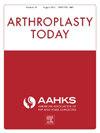Patient-Reported Outcomes in Robotic-Assisted vs Manual Cementless Total Knee Arthroplasty
IF 1.5
Q3 ORTHOPEDICS
引用次数: 0
Abstract
Background
Robotic-assisted total knee arthroplasty (RA-TKA) was introduced to provide surgeons with virtual preoperative planning and intraoperative information to achieve the desired surgical goals in an effort to improve patient outcomes. The purpose of this study was to compare clinical outcomes and patient-reported outcome measures following primary TKA using RA-TKA vs manual instrumentation.
Methods
This was a retrospective cohort review study comparing 393 primary RA-TKAs vs 312 manual TKAs at a minimum 2-year follow-up. The same cementless implant design was utilized in all cases at a single institution. There were no significant differences in age or gender between groups. Outcome measures included range-of-motion, Knee Society (KSS), Western Ontario and McMaster Universities Osteoarthritis Index, Forgotten Joint Score-12, Knee Injury and Osteoarthritis Outcome Score for Joint Replacement, and overall patient satisfaction scores along with complications and survivorship.
Results
Compared to manual TKA, the RA-TKA group had significant higher postoperative KSS Function and Knee scores, Western Ontario and McMaster Universities Osteoarthritis Index, and Knee Injury and Osteoarthritis Outcome Score for Joint Replacement scores (P < .001). A total percentage of 95.0% of RA-TKA vs 87.4% of manual TKAs were very satisfied or satisfied (P = .001). Survivorship with all-cause failure as the endpoint at 3 years was 96.9% in the RA-TKA group compared to 95.8% in the manual group (P = .54).
Conclusions
RA-TKA demonstrated significant improvement over manual jig-based instruments in KSS Function, KSS Knee, Western Ontario and McMaster Universities Osteoarthritis Index, Knee Injury and Osteoarthritis Outcome Score for Joint Replacement, and patient satisfaction scores following primary TKA with no differences in complications and revision incidence. RA-TKA provided a virtual 3-dimensional preoperative plan along with intraoperative information for adjustments to approximate the patients' native joint line and achieve a well-balanced soft-tissue sleeve about the knee for primary TKA.
机器人辅助与手动无骨水泥全膝关节置换术的患者报告结果对比
背景引入机器人辅助全膝关节置换术(RA-TKA)是为了向外科医生提供虚拟术前计划和术中信息,以实现预期的手术目标,从而改善患者的预后。本研究的目的是比较使用RA-TKA与手动器械进行初次TKA后的临床疗效和患者报告的疗效指标。方法这是一项回顾性队列回顾研究,比较了393例RA-TKA与312例手动TKA在至少2年随访后的临床疗效。所有病例均在一家医疗机构采用相同的无骨水泥植入设计。两组患者的年龄和性别无明显差异。结果测量包括活动范围、膝关节协会(KSS)、西安大略和麦克马斯特大学骨关节炎指数、Forgotten Joint Score-12、膝关节损伤和关节置换骨关节炎结果评分、患者总体满意度评分以及并发症和存活率。结果与徒手 TKA 相比,RA-TKA 组的术后 KSS 功能和膝关节评分、西安大略和麦克马斯特大学骨关节炎指数以及膝关节损伤和骨关节炎关节置换结果评分均明显更高(P <.001)。95.0%的RA-TKA患者与87.4%的人工TKA患者表示非常满意或满意(P = .001)。结论RA-TKA在初级TKA后的KSS功能、KSS膝关节、西安大略和麦克马斯特大学骨关节炎指数、膝关节损伤和骨关节炎关节置换结果评分以及患者满意度评分方面都比基于手动夹具的工具有显著改善,而在并发症和翻修发生率方面没有差异。RA-TKA提供了虚拟三维术前计划和术中调整信息,以接近患者的原生关节线,并在初次TKA中实现膝关节软组织套筒的良好平衡。
本文章由计算机程序翻译,如有差异,请以英文原文为准。
求助全文
约1分钟内获得全文
求助全文
来源期刊

Arthroplasty Today
Medicine-Surgery
CiteScore
2.90
自引率
0.00%
发文量
258
审稿时长
40 weeks
期刊介绍:
Arthroplasty Today is a companion journal to the Journal of Arthroplasty. The journal Arthroplasty Today brings together the clinical and scientific foundations for joint replacement of the hip and knee in an open-access, online format. Arthroplasty Today solicits manuscripts of the highest quality from all areas of scientific endeavor that relate to joint replacement or the treatment of its complications, including those dealing with patient outcomes, economic and policy issues, prosthetic design, biomechanics, biomaterials, and biologic response to arthroplasty. The journal focuses on case reports. It is the purpose of Arthroplasty Today to present material to practicing orthopaedic surgeons that will keep them abreast of developments in the field, prove useful in the care of patients, and aid in understanding the scientific foundation of this subspecialty area of joint replacement. The international members of the Editorial Board provide a worldwide perspective for the journal''s area of interest. Their participation ensures that each issue of Arthroplasty Today provides the reader with timely, peer-reviewed articles of the highest quality.
 求助内容:
求助内容: 应助结果提醒方式:
应助结果提醒方式:


